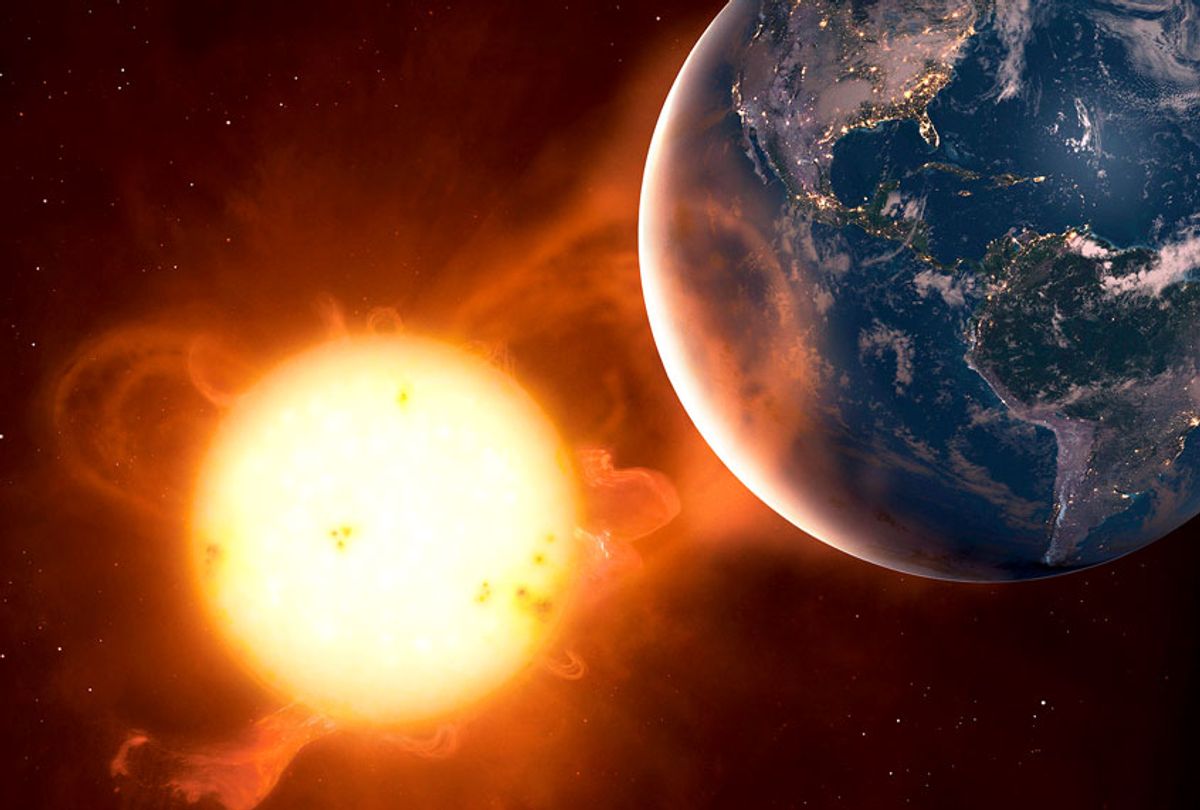A solar storm from 14,300 years ago previews how Earth may one day plunge into darkness

When the Sun suddenly erupts, it creates what’s known as solar flares and coronal mass ejections — and they can cause a lot of mischief when the resultant electromagnetic radiation reaches Earth. One particularly intense geomagnetic storm in 1859, the so-called Carrington Event, knocked out telegraph lines and tricked many people into thinking it was morning at 1 a.m. Yet that event pales in comparison to another solar storm that occurred 14,300 years ago, according to a recent study in the journal Philosophical Transactions of the Royal Society A.
According to their research, the largest solar storm ever detected struck Earth 14,300 years ago, leaving evidence of its occurrence on the trees. Flash forward fourteen millennia and change, and scientists can use those ancient tree rings to partially reconstruct what happened during that solar event. The team of researchers were assembled from the Collège de France, CEREGE, IMBE, Aix-Marseille University and the University of Leeds. Their mission: Study the ancient trees in the banks of the Drouzet River, near Gap, in the Southern French Alps.
“Finding such a collection of preserved trees was truly exceptional.”
Specifically, the scientists compared a radiocarbon spike in those ancient tree rings with measurements of beryllium, an element found in Greenland ice cores that likewise provide records of ancient solar activity. After analyzing the resulting data, the scientists arrived at the hypothesis that a massive solar storm blanketed Earth’s atmosphere with wave after wave of energetic particles. The end result was the radiocarbon spikes observed in the tree rings. This type of overall massive solar storm is known as a Miyake Event, and this is the ninth one known to have occurred to Earth within a 15,000 year period.
“Extreme solar storms could have huge impacts on Earth,” Tim Heaton, Professor of Applied Statistics in the School of Mathematics at the University of Leeds and co-author of the paper, said in a statement. “Such super storms could permanently damage the transformers in our electricity grids, resulting in huge and widespread blackouts lasting months.”
In that same statement Cécile Miramont, associate professor of Paleoenvironments and Paleoclimates at IMBE, Aix-en-Provence University, described how the scientists were only able to learn about this literally Earth-changing Miyake Event because of remarkable good luck.
“Finding such a collection of preserved trees was truly exceptional,” Miramont explained. “By comparing the widths of the individual tree rings in the multiple tree trunks, we then carefully pieced together the separate trees to create a longer timeline using a method called dendrochronology. This allowed us to discover invaluable information on past environmental changes and measure radiocarbon over an uncharted period of solar activity.”
Want more health and science stories in your inbox? Subscribe to Salon’s weekly newsletter Lab Notes.
This type of overall massive solar storm is known as a Miyake Event, and this is the ninth one known to have occurred to Earth within a 15,000 year period.
Not everyone is convinced by the researchers’ hypothesis. Speaking to The Washington Post, researcher Florian Adolphi argued that the scientists needed to seek out concentrations of a different isotope, the chlorine-36 isotope, which may also explains the radiocarbon spike in a single year detected in the tree rings.
“Similarly, it remains to be tested, whether the event was really the strongest of the so far observed events,” Adolphi, a senior scientist at the Alfred Wegener Institute for Polar and Marine Research in Germany, told the Post. Despite his criticisms,, Adolphi also said the study was “well done.”
Solar storms in the present have real world implications, with one outburst of space weather surprising SpaceX CEO Elon Musk, who lost 40 of his satellites to a geomagnetic storm after launching during active solar weather. Musk’s company lost roughly $50 million on the failed venture, and astrophysicist Jonathan McDowell of the Harvard-Smithsonian Center for Astrophysics told CNBC that “to lose most of the batch is unheard of. This is huge compared to anything that’s happened before.”
Musk’s solar storm surprise is nothing compared to the surprise experienced by those who might live through earthquakes due to solar events. That at least is the theory promulgated by a controversial 2020 paper which linked solar activity to earthquakes by theorizing that clusters of protons from the sun may correlate to large earthquakes on Earth. Yet in the words at the time of John Emilio Vidale, a seismologist at the University of Southern California, “I’m not an enthusiast. There are a lot of red flags in that paper. I’m frankly surprised it made it through review.”
Read more
on space travel

